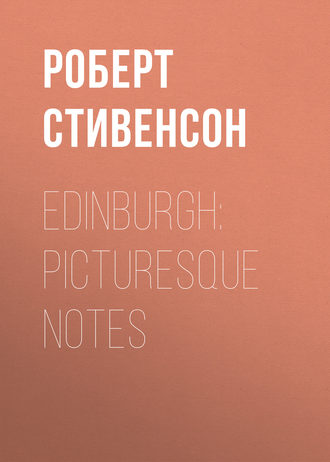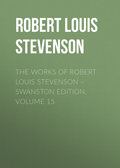
Роберт Льюис Стивенсон
Edinburgh: Picturesque Notes
CHAPTER VI. NEW TOWN – TOWN AND COUNTRY
It is as much a matter of course to decry the New Town as to exalt the Old; and the most celebrated authorities have picked out this quarter as the very emblem of what is condemnable in architecture. Much may be said, much indeed has been said, upon the text; but to the unsophisticated, who call anything pleasing if it only pleases them, the New Town of Edinburgh seems, in itself, not only gay and airy, but highly picturesque. An old skipper, invincibly ignorant of all theories of the sublime and beautiful, once propounded as his most radiant notion for Paradise: ‘The new town of Edinburgh, with the wind a matter of a point free.’ He has now gone to that sphere where all good tars are promised pleasant weather in the song, and perhaps his thoughts fly somewhat higher. But there are bright and temperate days – with soft air coming from the inland hills, military music sounding bravely from the hollow of the gardens, the flags all waving on the palaces of Princes Street – when I have seen the town through a sort of glory, and shaken hands in sentiment with the old sailor. And indeed, for a man who has been much tumbled round Orcadian skerries, what scene could be more agreeable to witness? On such a day, the valley wears a surprising air of festival. It seems (I do not know how else to put my meaning) as if it were a trifle too good to be true. It is what Paris ought to be. It has the scenic quality that would best set off a life of unthinking, open-air diversion. It was meant by nature for the realisation of the society of comic operas. And you can imagine, if the climate were but towardly, how all the world and his wife would flock into these gardens in the cool of the evening, to hear cheerful music, to sip pleasant drinks, to see the moon rise from behind Arthur’s Seat and shine upon the spires and monuments and the green tree-tops in the valley. Alas! and the next morning the rain is splashing on the windows, and the passengers flee along Princes Street before the galloping squalls.
It cannot be denied that the original design was faulty and short-sighted, and did not fully profit by the capabilities of the situation. The architect was essentially a town bird, and he laid out the modern city with a view to street scenery, and to street scenery alone. The country did not enter into his plan; he had never lifted his eyes to the hills. If he had so chosen, every street upon the northern slope might have been a noble terrace and commanded an extensive and beautiful view. But the space has been too closely built; many of the houses front the wrong way, intent, like the Man with the Muck-Rake, on what is not worth observation, and standing discourteously back-foremost in the ranks; and, in a word, it is too often only from attic-windows, or here and there at a crossing, that you can get a look beyond the city upon its diversified surroundings. But perhaps it is all the more surprising, to come suddenly on a corner, and see a perspective of a mile or more of falling street, and beyond that woods and villas, and a blue arm of sea, and the hills upon the farther side.
Fergusson, our Edinburgh poet, Burns’s model, once saw a butterfly at the Town Cross; and the sight inspired him with a worthless little ode. This painted country man, the dandy of the rose garden, looked far abroad in such a humming neighbourhood; and you can fancy what moral considerations a youthful poet would supply. But the incident, in a fanciful sort of way, is characteristic of the place. Into no other city does the sight of the country enter so far; if you do not meet a butterfly, you shall certainly catch a glimpse of far-away trees upon your walk; and the place is full of theatre tricks in the way of scenery. You peep under an arch, you descend stairs that look as if they would land you in a cellar, you turn to the back-window of a grimy tenement in a lane: – and behold! you are face-to-face with distant and bright prospects. You turn a corner, and there is the sun going down into the Highland hills. You look down an alley, and see ships tacking for the Baltic.
For the country people to see Edinburgh on her hill-tops, is one thing; it is another for the citizen, from the thick of his affairs, to overlook the country. It should be a genial and ameliorating influence in life; it should prompt good thoughts and remind him of Nature’s unconcern: that he can watch from day to day, as he trots officeward, how the Spring green brightens in the wood or the field grows black under a moving ploughshare. I have been tempted, in this connexion, to deplore the slender faculties of the human race, with its penny-whistle of a voice, its dull cars, and its narrow range of sight. If you could see as people are to see in heaven, if you had eyes such as you can fancy for a superior race, if you could take clear note of the objects of vision, not only a few yards, but a few miles from where you stand: – think how agreeably your sight would be entertained, how pleasantly your thoughts would be diversified, as you walked the Edinburgh streets! For you might pause, in some business perplexity, in the midst of the city traffic, and perhaps catch the eye of a shepherd as he sat down to breathe upon a heathery shoulder of the Pentlands; or perhaps some urchin, clambering in a country elm, would put aside the leaves and show you his flushed and rustic visage; or a fisher racing seawards, with the tiller under his elbow, and the sail sounding in the wind, would fling you a salutation from between Anst’er and the May.
To be old is not the same thing as to be picturesque; nor because the Old Town bears a strange physiognomy, does it at all follow that the New Town shall look commonplace. Indeed, apart from antique houses, it is curious how much description would apply commonly to either. The same sudden accidents of ground, a similar dominating site above the plain, and the same superposition of one rank of society over another, are to be observed in both. Thus, the broad and comely approach to Princes Street from the east, lined with hotels and public offices, makes a leap over the gorge of the Low Calton; if you cast a glance over the parapet, you look direct into that sunless and disreputable confluent of Leith Street; and the same tall houses open upon both thoroughfares. This is only the New Town passing overhead above its own cellars; walking, so to speak, over its own children, as is the way of cities and the human race. But at the Dean Bridge, you may behold a spectacle of a more novel order. The river runs at the bottom of a deep valley, among rocks and between gardens; the crest of either bank is occupied by some of the most commodious streets and crescents in the modern city; and a handsome bridge unites the two summits. Over this, every afternoon, private carriages go spinning by, and ladies with card-cases pass to and fro about the duties of society. And yet down below, you may still see, with its mills and foaming weir, the little rural village of Dean. Modern improvement has gone overhead on its high-level viaduct; and the extended city has cleanly overleapt, and left unaltered, what was once the summer retreat of its comfortable citizens. Every town embraces hamlets in its growth; Edinburgh herself has embraced a good few; but it is strange to see one still surviving – and to see it some hundreds of feet below your path. Is it Torre del Greco that is built above buried Herculaneum? Herculaneum was dead at least; but the sun still shines upon the roofs of Dean; the smoke still rises thriftily from its chimneys; the dusty miller comes to his door, looks at the gurgling water, hearkens to the turning wheel and the birds about the shed, and perhaps whistles an air of his own to enrich the symphony – for all the world as if Edinburgh were still the old Edinburgh on the Castle Hill, and Dean were still the quietest of hamlets buried a mile or so in the green country.
It is not so long ago since magisterial David Hume lent the authority of his example to the exodus from the Old Town, and took up his new abode in a street which is still (so oddly may a jest become perpetuated) known as Saint David Street. Nor is the town so large but a holiday schoolboy may harry a bird’s nest within half a mile of his own door. There are places that still smell of the plough in memory’s nostrils. Here, one had heard a blackbird on a hawthorn; there, another was taken on summer evenings to eat strawberries and cream; and you have seen a waving wheatfield on the site of your present residence. The memories of an Edinburgh boy are but partly memories of the town. I look back with delight on many an escalade of garden walls; many a ramble among lilacs full of piping birds; many an exploration in obscure quarters that were neither town nor country; and I think that both for my companions and myself, there was a special interest, a point of romance, and a sentiment as of foreign travel, when we hit in our excursions on the butt-end of some former hamlet, and found a few rustic cottages embedded among streets and squares. The tunnel to the Scotland Street Station, the sight of the trains shooting out of its dark maw with the two guards upon the brake, the thought of its length and the many ponderous edifices and open thoroughfares above, were certainly things of paramount impressiveness to a young mind. It was a subterranean passage, although of a larger bore than we were accustomed to in Ainsworth’s novels; and these two words, ‘subterreanean passage,’ were in themselves an irresistible attraction, and seemed to bring us nearer in spirit to the heroes we loved and the black rascals we secretly aspired to imitate. To scale the Castle Rock from West Princes Street Gardens, and lay a triumphal hand against the rampart itself, was to taste a high order of romantic pleasure. And there are other sights and exploits which crowd back upon my mind under a very strong illumination of remembered pleasure. But the effect of not one of them all will compare with the discoverer’s joy, and the sense of old Time and his slow changes on the face of this earth, with which I explored such corners as Cannonmills or Water Lane, or the nugget of cottages at Broughton Market. They were more rural than the open country, and gave a greater impression of antiquity than the oldest land upon the High Street. They too, like Fergusson’s butterfly, had a quaint air of having wandered far from their own place; they looked abashed and homely, with their gables and their creeping plants, their outside stairs and running mill-streams; there were corners that smelt like the end of the country garden where I spent my Aprils; and the people stood to gossip at their doors, as they might have done in Colinton or Cramond.
In a great measure we may, and shall, eradicate this haunting flavour of the country. The last elm is dead in Elm Row; and the villas and the workmen’s quarters spread apace on all the borders of the city. We can cut down the trees; we can bury the grass under dead paving-stones; we can drive brisk streets through all our sleepy quarters; and we may forget the stories and the playgrounds of our boyhood. But we have some possessions that not even the infuriate zeal of builders can utterly abolish and destroy. Nothing can abolish the hills, unless it be a cataclysm of nature which shall subvert Edinburgh Castle itself and lay all her florid structures in the dust. And as long as we have the hills and the Firth, we have a famous heritage to leave our children. Our windows, at no expense to us, are most artfully stained to represent a landscape. And when the Spring comes round, and the hawthorns begin to flower, and the meadows to smell of young grass, even in the thickest of our streets, the country hilltops find out a young man’s eyes, and set his heart beating for travel and pure air.
CHAPTER VII. THE VILLA QUARTERS
Mr. Ruskin’s denunciation of the New Town of Edinburgh includes, as I have heard it repeated, nearly all the stone and lime we have to show. Many however find a grand air and something settled and imposing in the better parts; and upon many, as I have said, the confusion of styles induces an agreeable stimulation of the mind. But upon the subject of our recent villa architecture, I am frankly ready to mingle my tears with Mr. Ruskin’s, and it is a subject which makes one envious of his large declamatory and controversial eloquence.
Day by day, one new villa, one new object of offence, is added to another; all around Newington and Morningside, the dismallest structures keep springing up like mushrooms; the pleasant hills are loaded with them, each impudently squatted in its garden, each roofed and carrying chimneys like a house. And yet a glance of an eye discovers their true character. They are not houses; for they were not designed with a view to human habitation, and the internal arrangements are, as they tell me, fantastically unsuited to the needs of man. They are not buildings; for you can scarcely say a thing is built where every measurement is in clamant disproportion with its neighbour. They belong to no style of art, only to a form of business much to be regretted.
Why should it be cheaper to erect a structure where the size of the windows bears no rational relation to the size of the front? Is there any profit in a misplaced chimney-stalk? Does a hard-working, greedy builder gain more on a monstrosity than on a decent cottage of equal plainness? Frankly, we should say, No. Bricks may be omitted, and green timber employed, in the construction of even a very elegant design; and there is no reason why a chimney should be made to vent, because it is so situated as to look comely from without. On the other hand, there is a noble way of being ugly: a high-aspiring fiasco like the fall of Lucifer. There are daring and gaudy buildings that manage to be offensive, without being contemptible; and we know that ‘fools rush in where angels fear to tread.’ But to aim at making a common-place villa, and to make it insufferably ugly in each particular; to attempt the homeliest achievement, and to attain the bottom of derided failure; not to have any theory but profit and yet, at an equal expense, to outstrip all competitors in the art of conceiving and rendering permanent deformity; and to do all this in what is, by nature, one of the most agreeable neighbourhoods in Britain: – what are we to say, but that this also is a distinction, hard to earn although not greatly worshipful?
Indifferent buildings give pain to the sensitive; but these things offend the plainest taste. It is a danger which threatens the amenity of the town; and as this eruption keeps spreading on our borders, we have ever the farther to walk among unpleasant sights, before we gain the country air. If the population of Edinburgh were a living, autonomous body, it would arise like one man and make night hideous with arson; the builders and their accomplices would be driven to work, like the Jews of yore, with the trowel in one hand and the defensive cutlass in the other; and as soon as one of these masonic wonders had been consummated, right-minded iconoclasts should fall thereon and make an end of it at once.
Possibly these words may meet the eye of a builder or two. It is no use asking them to employ an architect; for that would be to touch them in a delicate quarter, and its use would largely depend on what architect they were minded to call in. But let them get any architect in the world to point out any reasonably well-proportioned villa, not his own design; and let them reproduce that model to satiety.







